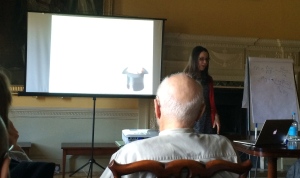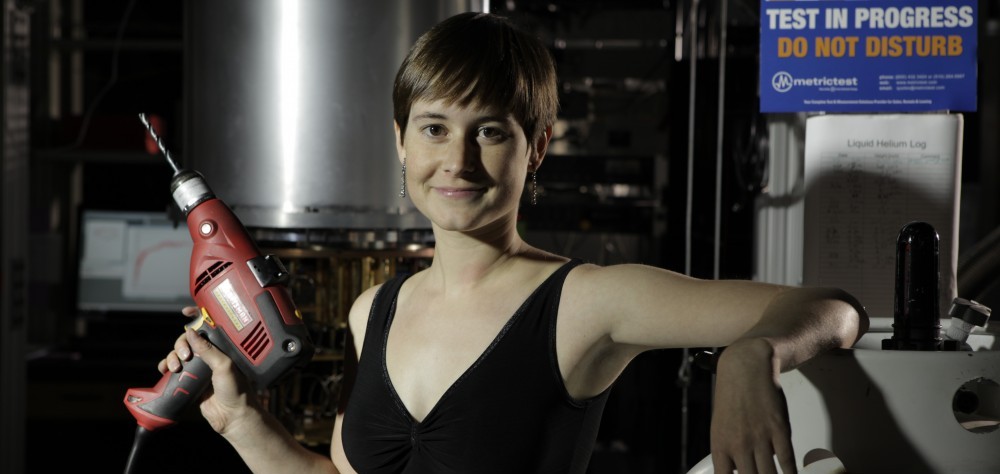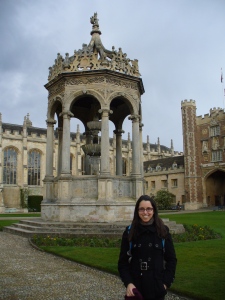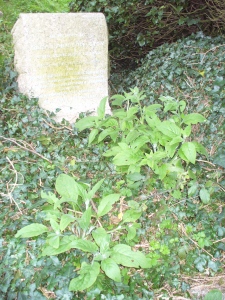Science evolves on Facebook.
On Facebook last fall, I posted about statistical mechanics. Statistical mechanics is the physics of hordes of particles. Hordes of molecules, for example, form the stench seeping from a clogged toilet. Hordes change in certain ways but not in the reverse ways, suggesting time points in a direction. Once a stink diffuses into the hall, it won’t regroup in the bathroom. The molecules’ locations distinguish past from future.
The post attracted a comment by Ian Durham, associate professor of physics at St. Anselm College. Minutes later, we were instant-messaging about infinitely long evolutions.* The next day, I sent Ian a paper draft. His reply made me jump more than a whiff of a toilet would. Would I discuss the paper at a conference he was co-organizing?
I almost replied, Are you sure?
Then I almost replied, Yes, please!
The conference, “Eddington and Wheeler: Information and Interaction,” unfolded this March at the University of Cambridge. Cambridge employed Sir Arthur Eddington, the astronomer whose 1919 observation of starlight during an eclipse catapulted Einstein’s general relativity to fame. Decades later, John Wheeler laid groundwork for quantum information. Though aware of Eddington’s observation, I hadn’t known he’d researched stat mech. I hadn’t known his opinions about time. Time owns a high-rise in my heart; see the fussiness with which I catalogue “last fall,” “minutes later,” and “the next day.” Conference-goers shared news about time in the Old Combination Room at Cambridge’s Trinity College. Against the room’s wig-filled portraits, our projector resembled a souvenir misplaced by a time traveler.
Presenter one, Huw Price, argued that time has no arrow. It appears to in our universe: We remember the past and anticipate the future. Once a stench diffuses, it doesn’t regroup. The stench illustrates the Second Law of Thermodynamics, the assumption that entropy increases.
If “entropy” doesn’t ring a bell, never mind; we’ll dissect it in future articles. Suffice it to say that (1) thermodynamics is a branch of physics related to stat mech; (2) according to the Second Law of Thermodynamics, something called “entropy” increases; (3) entropy’s rise distinguishes the past from the future by associating the former with a low entropy and the latter with a large entropy; and (4) a stench’s diffusion illustrates the Second Law and time’s flow.
In as many universes in which entropy increases (time flows in one direction), in so many universe does entropy decrease (does time flow oppositely). So, said Huw Price, postulated the 19th-century stat-mech founder Ludwig Boltzmann. Why would universes pair up? For the reason why, driving across a pothole, you not only fall, but also rise. Each fluctuation from equilibrium—from a flat road—involves an upward path and a downward. The upward path resembles a universe in which entropy increases; the downward, a universe in which entropy decreases. Every down pairs with an up. Averaged over universes, time has no arrow.
Freidel Weinert, presenter five, argued the opposite. Time has an arrow, he said, and not because of entropy.
Ariel Caticha discussed an impersonator of time. Using a cousin of MaxEnt, he derived an equation identical to Schrödinger’s. MaxEnt, short for “the Maximum Entropy Principle,” is a tool used in stat mech. Schrödinger’s Equation describes how quantum systems evolve. To draw from Schrödinger’s Equation predictions about electrons and atoms, physicists assume that features of reality resemble certain bits of math. We assume, for example, that the t in Schrödinger’s Equation represents time. A t appeared in Ariel’s twin of Schrödinger’s Equation. But Ariel didn’t assume what physicists usually assume. MaxEnt motivated his assumptions. Interpreting Ariel’s equation poses a challenge. If a variable acts like time and smells like time, does it represent time?**

A presenter uses the anachronistic projector. The head between screen and camera belongs to David Finkelstein, who helped develop the theory of general relativity checked by Eddington.
Like Ariel, Bill Wootters questioned time’s role in arguments. The co-creator of quantum teleportation wondered why one tenet of quantum physics has the form it has. Using quantum mechanics, we can’t predict certain experiments’ outcomes. We can predict probabilities—the chance that some experiment will yield Possible Outcome 1, the chance that the experiment will yield Possible Outcome 2, and so on. To calculate these probabilities, we square numbers. Why square? Why don’t the probabilities depend on cubes?
To explore this question, Bill told a story. Suppose some experimenter runs these experiments on Monday and those on Tuesday. When evaluating his story, Bill pointed out a hole: Replacing “Monday” and “Tuesday” with “eight o’clock” and “nine” wouldn’t change his conclusion. Which replacements wouldn’t change it, and which would? To what can we generalize those days? We couldn’t answer his questions on the Sunday he asked them.
Little of presentation twelve concerned time. Rüdiger Schack introduced QBism, an interpretation of quantum mechanics that sounds like “cubism.” Casting quantum physics in terms of experimenters’ actions, Rüdiger mentioned time. By the time of the mention, I couldn’t tell what anyone meant by “time.” Raising a hand, I asked for clarification.
“You are young,” Rüdiger said. “But you will grow old and die.”
The comment clanged like the slam of a door. It echoed when I followed Ian into Ascension Parish Burial Ground. On Cambridge’s outskirts, conference-goers visited Eddington’s headstone. We found Wittgenstein’s near an uneven footpath; near tangles of undergrowth, Nobel laureates’. After debating about time, we marked its footprints. Paths of glory lead but to the grave.
Paths touched by little glory, I learned, have perks. As Rüdiger noted, I was the greenest participant. As he had the manners not to note, I was the least distinguished and the most ignorant. Studenthood freed me to raise my hand, to request clarification, to lack opinions about time. Perhaps I’ll evolve opinions at some t, some Monday down the road. That Monday feels infinitely far off. These days, I’ll stick to evolving science—using that other boon of youth, Facebook.
*You know you’re a theoretical physicist (or a physicist-in-training) when you debate about processes that last till kingdom come.
** As long as the variable doesn’t smell like a clogged toilet.
For videos of the presentations—including the public lecture by best-selling author Neal Stephenson—stay tuned to http://informationandinteraction.wordpress.com. My presentation appears here.
With gratitude to Ian Durham and Dean Rickles for organizing “Information and Interaction” and for the opportunity to participate. With thanks to the other participants for sharing their ideas and time.



I feel that time has direction, even though I don’t have that many solid arguments as people provided in the conference. But I hope time has no direction, so that our studentness, the gut of asking any innocent questions, can always live.
The headstone makes the whole story very philosophical 🙂
I won’t be surprised if you acquire solid arguments, with years, about time. 🙂
Yes, visiting an overgrown cemetery after hearing so many speeches about entropy seemed too fitting — as though plucked from the pages of a book.
In regard to the literature of entropy, the Max Planck Institute for the History of Science provides (on-line and free-as-in-freedom) an outstanding conference series that includes (in particular) Traditions and Transformations in the History of Quantum Physics (2010) and Research and Pedagogy : A History of Quantum Physics through Its Textbooks (2013).
Superficially these works are dry, yet they are founded upon events that were filled with passion and drama. To a young writer-colleague … who will attend this years Odyssey Writing Workshop … I have commended the intertwining entropy-driven lives of Fritz Haber, his scientist-wife Clara Immerwahr, his assistant Otto Sackur, and their colleagues Hugo Tetrode, and Paul Drude (it was Sackur and Tetrode conceived the celebrated Sackur-Tetrode entropy function, that first determined the numerical value of hbar).
Of these five researchers — whose personal and professional lives were richly intertwined — two died by suicide, two died young, and one lived to experience professional triumph and devastating spiritual tragedy. Their saga amounts to a “Big Bang Theory” … for adults!
The web page “Founders of thermodynamics and suicide” documents many further such examples, and David Goodstein hints at this dark history in the introduction to his textbook States of Matter (1975):
What’s going on? One consideration is that “Thermodynamics is 21st century physics that fell accidentally into the 19th century”, which is why “Every mathematician knows that it is impossible to understand any elementary course in thermodynamics,” and also why “the age in which we live is the one in which we are discovering the fundamental laws of nature, and that day will never come again.” (to first borrow from Ed Witten, and then quote literally from Vladimir Arnold and Richard Feynman).
Nowadays we are slowly translating our understanding of thermodynamics into the natural language of modern mathematics. This process is “dissolving the boundaries between research and pedagogy”. and also helping us to appreciate “Otto Sackur’s pioneering exploits in the quantum theory of gases” (the quoted phrases are the titles of articles by Massimiliano Badino in the above-mentioned Max Planck Institute proceedings).
This history teaches plainly that today as in the past, the ongoing process of quantum-theoretic conception and exposition is fated to excite strong individual passions, and fated also to touch upon the most fundamental strategic challenges of our era.
This is GOOD!
Exercise Watch Naomi Oreskes’ 18-minute lecture “Scientific Consensus and the Role and Character of Scientific Dissent,” which was given as the summary lecture (at 8:00:10 of the video) of last week’s Pontifical Academy workshop Sustainable Humanity, Sustainable Nature: Our Responsibility.
While watching, mentally substitute “quantum thermodynamical science” for “climate science.”
It’s evident — isn’t it? — from Oreskes’ historical and economic analysis, that a free, prosperous and secure planet, with ten billion people upon it, must deploy technologies that press against the limits to efficiency, speed, and energy economy that quantum thermodynamics imposes.
Conclusion We had better get busy and grapple effectively with our century’s challenges and opportunities! And we had better be ready to deploy the vastly powerful, vastly beautiful, vastly open-ended mathematical armamentarium that Arnold and Witten (and an army of late-20th-century dynamicists) has so fortunately created for our generation.
And hopefully, our generation’s quantum research efforts (both fundamental and applied) can have a happier outcome than the all-too-similar efforts of the generation of Fritz Haber, Clara Immerwahr, Otto Sackur, Hugo Tetrode, and Paul Drude.
Errata Historian/scientist Naomi Oreskes’ lecture starts at 08:07:10 (not 08:00:10 as given above; the links begin the video at the correct time). The title-slide of the talk, which is “The role of scientists: what is ‘our responsibility’?”, differs from the title given in the programme, which is “Scientific consensus and the role and character of scientific dissent.”
Oreskes’ concluding slide is commended generally to the consideration STEM researchers in general, and to young quantum researchers in particular:
Perhaps Feynman’s observation, “We are struck by the very large number of different physical viewpoints and widely different mathematical formulations that are all equivalent to one another”, can apply both to the science that we do and to the ways that we do science.
Thanks for sharing your thoughts and the references, John. The subject has a rich history indeed. And the “Now it is our turn to study statistical mechanics” quote makes for a memorable first lecture in an undergraduate stat-phys class. 🙂
Nicole, STEM students should be aware too that
• Multiple pioneers of quantum dynamical science — including Dirac, Schwinger, Feynman, von Neumann, and Onsager — worked on thermodynamics (particularly on transport dynamics).
• Yet regrettably their works are held as state-secrets and/or trade-secrets even to the present day.
• This secrecy has severely impeded the evolution of quantum thermodynamical understanding and pedagogy toward greater naturality, universality, and physicality.
• And so there is a wide-open opportunity — a wonderfully transgressive opportunity — for the present generation of young quantum researchers to “dissolve the boundaries between research and pedagogy“ (in Massimiliano Badino’s useful phrase):
Present Realities Across mathematical, engineering, and medical disciplines broadly, Badino’s 21st century “dissolving of boundaries” is well underway, in that a “fundamental reshaping of the pedagogical tradition” is irretrievably underway in these STEM discipliens.
Potential Tragedies It would be regrettable — as a tragically lost opportunity of students — were quantum physics pedagogy to lag behind, leaving students unconscious of the restrictive bounds to cognition (mathematical cognition especially) that are deplorably imposed by the 20th century’s cherished-but-obsolescent quantum physics pedagogy.
A Modest Proposal “Let’s ban Feynman” should be the slogan of every 21st century undergraduate physics society!
In further reference to the category of enterprises that might be called “Dissolving the boundaries between research and ⟨name the discipline⟩”, Dick Lipton and Ken Regan’s weblog Gödel’s Lost Letter and P=NP provides a link to “Interview with Preda Mihăilescu” (ECM Newsletter, June 2008).
Mihăilescu’s “dissolved boundary” is between pure mathematics and applied/enterprise mathematics (and Mihăilescu’s rich personal history contributes greatly to the interest of his interview).
Reversible cellular automata (RCA) provide a nice laboratory to play with the ideas of microscopic and macroscopic time. You can think of RCA as discrete classical field theories, with an invertible finite-state local dynamics. Often these have been called classical lattice gases in their physical applications—there are of course quantum versions as well. All sorts of physical phenomena have been captured in classical RCA models, including realistic hydrodynamics (rotationally invariant on a large scale), electrodynamics, complex materials simulations, even arrays of blobs with attractions and repulsions and momentum (and angular momentum) conservation, allowing composite structures that act like crystals made of “atoms”, with realistic elasticity, vibration, rotation, temperature, etc. Very rich RCA universes are possible.
If you start an RCA from a finite random initial state, half of the bits one and half zero, there is no large-scale evolution: a simple counting argument tells you that most random-looking states have to turn into other random-looking states under N steps of an invertible dynamics. If instead you start from a low-entropy state (a pattern of bits that can be substantially compressed by gzip, say), you can have a rich and interesting evolution, with growing complexity and structure and pattern at both large and small scales.
Now imagine there exists a toy universe of this kind that, if you could make it large enough, would support the evolution of stars and planets and biology and intelligence. Someone living in such a universe might, at some point, write a blog post about time and entropy. If we run the simulation long enough, eventually the whole finite-state system reaches a maximum entropy state, and in fact spends most of its time in such states. But the system is finite, so eventually it runs out of new states and must repeat a state.
Because the dynamics is invertible, every state has a unique predecessor and a unique successor: each evolution is a single closed cycle. Starting from any initial state, we will see no states repeated until we see the initial state again. Thus it’s easy to find out exactly what the end of the evolution looks like, just before the system “fluctuates” back into the initial state: just run backwards from the initial state! In this case, we again see an evolution from a low entropy initial state, with increasing entropy, with the same chemistry and stars and planets. But unless the initial state was time symmetric, we get a new set of stars and planets and blog-post authors running in this direction. Now if we imagine continuing to run in this direction for an unimaginably long time, we eventually get all the way around the cycle and see the blog post on time and entropy being unwritten, and watch the first evolution unwind back to the initial state.
Some observations. First, note that for macroscopic creatures living in this toy universe, macroscopic time always flows in the direction of increase in entropy: this is the direction in which events have macroscopic causes. Thus for half of the time evolution, the direction of microscopic time (i.e., the direction in which we perform the underlying cellular automata dynamics) is opposite to that of macroscopic time. It’s also noteworthy that late in the second simulation, as we watch the first evolution unwind, books appear before their authors exist. If we stop once we have reached a state containing a copy of the blog post on time and entropy surviving from after its author’s death, we can read the post without ever simulating the author! From our point of view running the simulation, the post was written by an accumulation of microscopic correlations.
Of course there’s no way for me to tell which way microscopic time is flowing as I write this, since I can only remember backwards in the direction of macroscopic causes, regardless of which way this invertible sequence of states is being computed microscopically…
Thanks for sharing the model. Cellular automata have been on my to-learn-about list for a few years. Though I don’t fancy the idea of the post’s being unwritten. 🙂
Pingback: Generally speaking | Quantum Frontiers
Pingback: I spy with my little eye…something algebraic. | Quantum Frontiers
Pingback: Hello, my name is QUANTUM MASTER EQUATION | Quantum Frontiers
Pingback: Bits, bears, and beyond in Banff | Quantum Frontiers
Pingback: Toward physical realizations of thermodynamic resource theories | Quantum Frontiers
Pingback: Discourse in Delft | Quantum Frontiers
Pingback: Some like it cold. | Quantum Frontiers
Pingback: Bringing the heat to Cal State LA | Quantum Frontiers
Pingback: It’s CHAOS! | Quantum Frontiers
Pingback: Decoding (the allure of) the apparent horizon | Quantum Frontiers
Pingback: Catching up with the quantum-thermo crowd | Quantum Frontiers
Pingback: Long live Yale’s cemetery | Quantum Frontiers
Pingback: Love in the time of thermo | Quantum Frontiers
Pingback: Love in the time of thermo |
Pingback: May you go from weakness to weakness | Quantum Frontiers
Pingback: Eight highlights from publishing a science book for the general public | Quantum Frontiers
Pingback: The quantum gold rush | Quantum Frontiers
Pingback: How I didn’t become a philosopher (but wound up presenting a named philosophy lecture anyway) | Quantum Frontiers
Pingback: Happy 200th birthday, Carnot’s theorem! | Quantum Frontiers